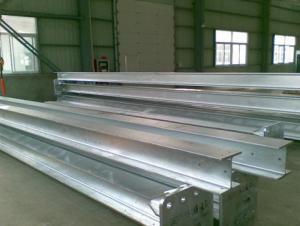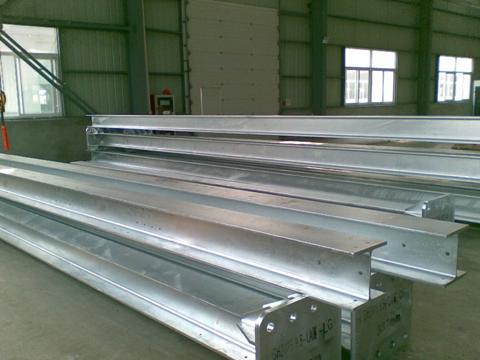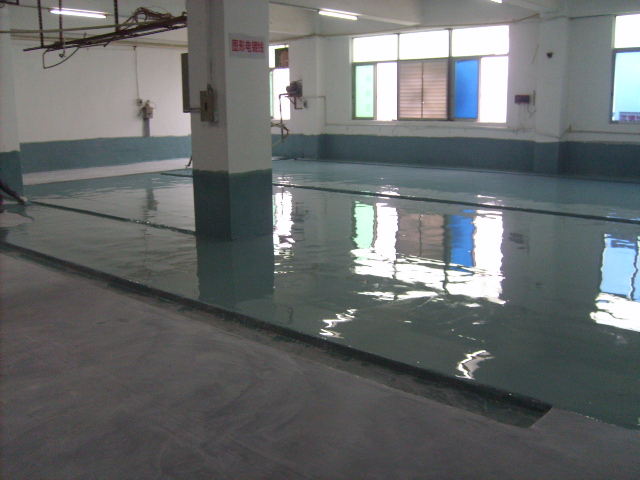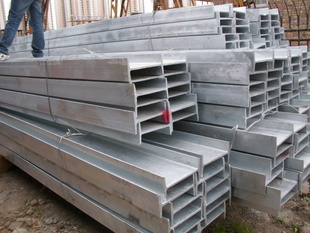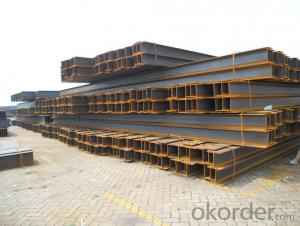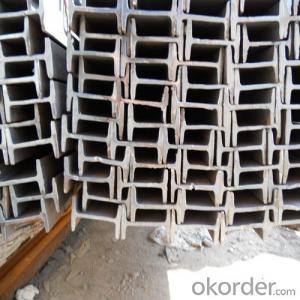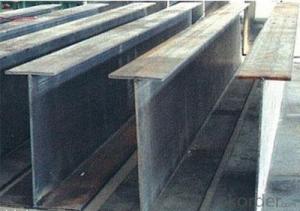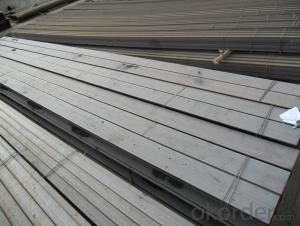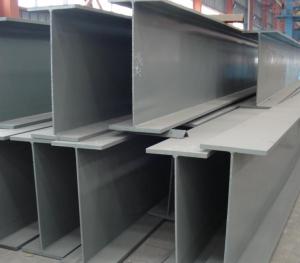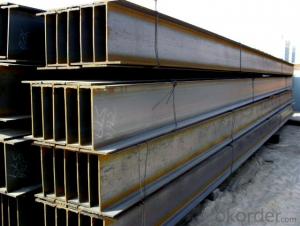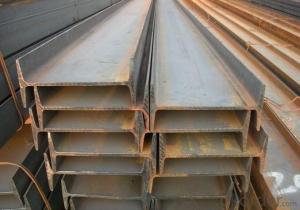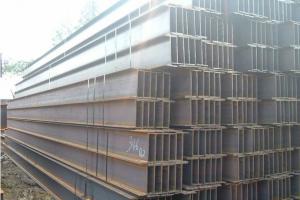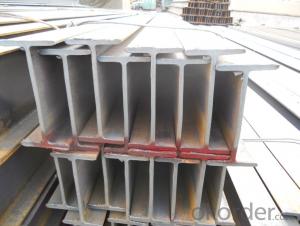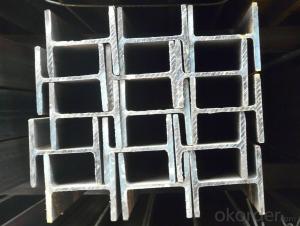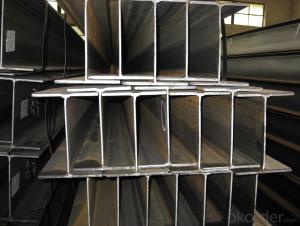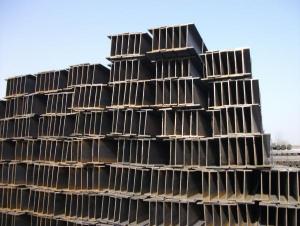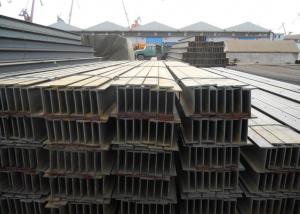Galvanized H Beam
- Loading Port:
- China Main Port
- Payment Terms:
- TT OR LC
- Min Order Qty:
- -
- Supply Capability:
- 5000 m.t./month
OKorder Service Pledge
OKorder Financial Service
You Might Also Like
Product Description:
Specifications of Galvanized H beam
1. Invoicing on theoretical weight or actual weight as customer request
2. Length: 6m, 12m as following table
3. Sizes:Zinc Thickness :15-80μ
(1).used for the plant, high-rise building construction
(2).used for the bridge, shipment building
(3).used for lifting and transportation machinery, equipment manufacturing base building
(4).used for the support, foundation pile manufacturing
Packaging & Delivery of Galvanized H beam
1. Packing: it is nude packed in bundles by steel wire rod
2. Bundle weight: not more than 3.5MT for bulk vessel; less than 3 MT for container load
3. Marks:
Color marking: There will be color marking on both end of the bundle for the cargo delivered by bulk vessel. That makes it easily to distinguish at the destination port.
Tag mark: there will be tag mark tied up on the bundles. The information usually including supplier logo and name, product name, made in
If loading by container the marking is not needed, but we will prepare it as customer request.
4.Transportation: the goods are delivered by truck from mill to loading port, the maximum quantity can be loaded is around 40MTs by each truck. If the order quantity cannot reach the full truck loaded, the transportation cost per ton will be little higher than full load.
5. Delivered by container or bulk vessel
Further performance and design information for galvanizing can be found in BS EN ISO 14713-1 AND BS EN ISO 14713-2. The durability performance of a galvanized coating depends solely on the corrosion rate of the environment in which it is placed. Corrosion rates for different environments can be found in BS EN ISO 14713-1 where typical corrosion rates are given with a description of the environment in which the steel would be used.
The process of hot-dip galvanizing results in a metallurgical bond between zinc and steel with a series of distinct iron-zinc alloys. The resulting coated steel can be used in much the same way as uncoated.
A typical hot-dip galvanizing line operates as follows:
Steel is cleaned using a caustic solution. This removes oil/grease, dirt, and paint.
The caustic cleaning solution is rinsed off.
The steel is pickled in an acidic solution to remove mill scale.
The pickling solution is rinsed off.
A flux, often zinc ammonium chloride is applied to the steel to inhibit oxidation of the cleaned surface upon exposure to air. The flux is allowed to dry on the steel and aids in the process of the liquid zinc wetting and adhering to the steel.
The steel is dipped into the molten zinc bath and held there until the temperature of the steel equilibrates with that of the bath.
The steel is cooled in a quench tank to reduce its temperature and inhibit undesirable reactions of the newly formed coating with the atmosphere
- Q: How do steel H-beams perform in areas with high snow load?
- Steel H-beams perform exceptionally well in areas with high snow loads due to their strong structural properties. The H-shape of the beams provides increased strength and resistance against bending and deflection under heavy snow loads. This makes steel H-beams an ideal choice for construction in regions prone to significant snowfall, ensuring the structural integrity and safety of the buildings.
- Q: Can steel H-beams be used for pedestrian bridges over highways?
- Yes, steel H-beams can be used for pedestrian bridges over highways. Steel H-beams are commonly used in bridge construction due to their high strength and durability. They provide structural support and can withstand heavy loads, making them suitable for pedestrian bridges over highways. Additionally, their flexibility allows for various design possibilities, ensuring the safety and stability of the bridge.
- Q: Are steel H-beams suitable for use in the construction of residential houses?
- Yes, steel H-beams are suitable for use in the construction of residential houses. They provide excellent structural support, are durable, and can withstand heavy loads. Additionally, their versatility allows for flexibility in architectural designs, offering homeowners a wide range of possibilities.
- Q: How do steel H-beams contribute to the overall durability of a structure?
- Steel H-beams contribute to the overall durability of a structure in several ways. Firstly, the unique design of H-beams provides excellent load-bearing capabilities, allowing them to support heavy loads and withstand high levels of stress. This makes them ideal for use in construction projects where structural integrity is paramount. Additionally, the use of steel in H-beams ensures their strength and durability. Steel is known for its high tensile strength, which means it can resist bending and deformation under pressure. This robustness helps prevent the beams from warping or collapsing, even when subjected to significant external forces. Furthermore, steel H-beams are highly resistant to corrosion and other forms of environmental damage. This ensures their longevity and reduces the need for frequent maintenance or repairs. Steel's resistance to fire and exposure to harsh elements also enhances the overall durability of the structure. Another factor contributing to the durability of H-beams is their versatility. These beams can be customized to fit specific design requirements, allowing for efficient distribution of weight and load across the structure. This flexibility ensures that the building can withstand diverse conditions and external factors more effectively. In conclusion, steel H-beams contribute to the overall durability of a structure through their load-bearing capabilities, high tensile strength, resistance to corrosion and environmental damage, and versatility in design. Their ability to withstand heavy loads, resist deformation, and maintain structural integrity over time makes them a crucial component in ensuring the long-lasting durability of any construction project.
- Q: How do steel H-beams contribute to sustainable transportation infrastructure?
- Steel H-beams contribute to sustainable transportation infrastructure in several ways: 1. Durability: Steel H-beams are extremely durable and can withstand heavy loads and harsh weather conditions. This means that they have a longer lifespan compared to other materials, reducing the need for frequent replacements. As a result, there is less material waste and energy consumption associated with the maintenance and repair of transportation infrastructure. 2. Cost-effectiveness: Steel H-beams are cost-effective due to their longevity and low maintenance requirements. By minimizing the need for repairs and replacements, they help save significant costs over the lifetime of a transportation infrastructure project. This allows for efficient allocation of resources, making it more sustainable in terms of budget management. 3. Recyclability: Steel is one of the most recycled materials in the world, and H-beams made from steel can be easily recycled at the end of their lifespan. This not only reduces the demand for virgin steel production but also minimizes the environmental impact associated with the extraction and manufacturing of new materials. By using recycled steel, transportation infrastructure projects can contribute to a circular economy and reduce their carbon footprint. 4. Design flexibility: Steel H-beams offer design flexibility, allowing engineers to create efficient and innovative transportation infrastructure solutions. Their high strength-to-weight ratio enables the construction of lighter structures, reducing the overall material consumption and transportation costs during construction. Additionally, their ability to span long distances without intermediate support pillars can reduce the need for additional materials and land use, making the infrastructure more environmentally friendly. 5. Resilience: Steel H-beams have excellent resistance to natural disasters, such as earthquakes and hurricanes. This resilience ensures the safety and stability of transportation infrastructure, reducing the risks associated with major events. By minimizing the damage caused by natural disasters, steel H-beams contribute to the sustainable operation and longevity of transportation networks. Overall, steel H-beams play a vital role in creating sustainable transportation infrastructure by offering durability, cost-effectiveness, recyclability, design flexibility, and resilience. By incorporating these beams into construction projects, we can enhance the longevity, safety, and environmental friendliness of transportation networks, thus contributing to a more sustainable future.
- Q: Are steel H-beams suitable for high-rise buildings?
- Yes, steel H-beams are suitable for high-rise buildings. Steel H-beams have several advantages that make them an ideal choice for high-rise construction. Firstly, their high strength-to-weight ratio allows for the creation of lighter and more efficient structures. This is crucial in high-rise buildings where the weight of the structure needs to be minimized to reduce the load on the foundation and to improve overall stability. Secondly, steel H-beams have excellent load-bearing capacity, which is essential for supporting the weight of multiple floors and withstanding the forces exerted by wind, earthquakes, and other external factors. The inherent rigidity and strength of steel allow for the construction of tall buildings that can withstand these forces without compromising on stability or safety. Moreover, steel H-beams offer greater flexibility in terms of design and construction. Their versatility allows architects and engineers to create innovative and complex structures, enabling them to maximize floor space and create visually appealing designs. The ability to easily connect and join steel H-beams also facilitates faster construction, reducing overall project timelines. Furthermore, steel is a highly durable and long-lasting material. It is resistant to corrosion, fire, and pests, making it an ideal choice for high-rise buildings that are expected to have a long lifespan. Steel H-beams also require minimal maintenance, which is advantageous in terms of cost and convenience. In conclusion, steel H-beams are indeed suitable for high-rise buildings due to their high strength, load-bearing capacity, flexibility in design, and durability. These factors make steel H-beams a preferred choice for architects, engineers, and construction professionals when constructing tall buildings.
- Q: Can steel H-beams be used for supporting highway or railway bridges?
- Certainly, steel H-beams are suitable for supporting highway or railway bridges. Due to their exceptional load-bearing capacity and structural strength, steel H-beams are extensively utilized in bridge construction. They offer a robust framework for constructing bridges that can endure heavy traffic loads and diverse environmental conditions. The H-shape of the beams permits superior load distribution, making them perfect for supporting vast spans and heavy loads commonly encountered in highway or railway bridges. Furthermore, steel H-beams are recognized for their durability, resilience, and resistance to corrosion, thus making them appropriate for long-term utilization in bridge construction. Moreover, steel H-beams are easily fabricated and installed, enhancing their appeal for bridge construction projects. By employing appropriate engineering design and construction techniques, steel H-beams can provide the necessary support and stability essential for safe and efficient transportation across highways or railways. Nevertheless, it is crucial to emphasize that engineers and architects must meticulously determine the specific design and dimensions of the steel H-beams based on the requirements of the bridge project, such as span length, load-bearing capacity, and projected traffic loads. Additionally, regular inspections and maintenance must be conducted to ensure the sustained safety and durability of the bridge structure.
- Q: Are steel H-beams suitable for structures with dynamic loads?
- Structures with dynamic loads can benefit from using steel H-beams. These beams, also referred to as I-beams, are commonly utilized in construction due to their high strength-to-weight ratio, which makes them ideal for supporting heavy loads. The shape of an H-beam provides excellent resistance to bending, making it well-suited for structures experiencing dynamic loads like bridges, cranes, and high-rise buildings. Steel H-beams possess exceptional structural integrity, enabling them to withstand the forces generated by dynamic loads such as vibrations, impacts, and cyclic loading. They are designed to evenly distribute the load along their length, minimizing stress concentrations and preventing deformation or failure. Furthermore, steel is a durable material that exhibits excellent fatigue resistance. This means that H-beams can endure repeated loading and unloading without compromising their mechanical properties. As a result, they are highly suitable for structures that encounter varying or dynamic loads over time. Moreover, steel H-beams can be tailored to meet specific structural requirements, including length, size, and strength. This versatility allows them to be fabricated and connected to form intricate structural systems that efficiently handle dynamic loads. In conclusion, steel H-beams are a reliable and extensively used option in structural engineering for buildings and infrastructure subjected to dynamic loads.
- Q: What are the mechanical properties of steel H-beams?
- Steel H-beams possess a variety of mechanical characteristics that render them suitable for a broad range of uses. To commence, H-beams exhibit a remarkable degree of tensile strength, enabling them to endure substantial amounts of tension or pulling forces without fracturing or distorting. This attribute renders them ideal for implementation in structures that necessitate the support of hefty loads, such as bridges or high-rise buildings. Moreover, H-beams boast exceptional yield strength, denoting the extent of stress a material can endure prior to undergoing permanent deformation. This feature guarantees that H-beams can withstand bending or buckling under substantial loads, thereby ensuring structural stability and preventing collapse. An additional significant mechanical property of steel H-beams is their rigidity or modulus of elasticity. This attribute determines the extent to which a material will deform under a given amount of stress. H-beams possess a high modulus of elasticity, signifying that they are comparatively inflexible and can sustain their shape and structural integrity even when subjected to substantial loads. Furthermore, steel H-beams exhibit commendable resistance to fatigue, permitting them to endure repeated cycles of loading and unloading without failure. This characteristic is pivotal in structures subject to dynamic loads, such as bridges or cranes, where the material is incessantly exposed to varying forces. Lastly, H-beams possess exceptional weldability, facilitating their simple fusion to form larger structures or modify existing ones. This attribute is crucial for construction endeavors that demand flexibility and adaptability in design. In conclusion, the mechanical properties of steel H-beams, comprising high tensile strength, yield strength, rigidity, fatigue resistance, and weldability, render them a popular choice in the fields of structural engineering and construction.
- Q: Can steel H-beams be used in the construction of industrial buildings?
- Yes, steel H-beams can be used in the construction of industrial buildings. Steel H-beams are commonly used as structural support elements in industrial buildings due to their strength, durability, and versatility. They are designed to withstand heavy loads and provide stability to the structure. H-beams are capable of spanning long distances, making them suitable for wide open spaces often found in industrial buildings. Additionally, steel H-beams can be easily fabricated and installed, reducing construction time and costs. They are also fire-resistant and can withstand extreme weather conditions, making them a reliable choice for industrial buildings. Overall, steel H-beams are a popular choice for construction in industrial settings due to their strength, durability, and suitability for heavy-duty applications.
Send your message to us
Galvanized H Beam
- Loading Port:
- China Main Port
- Payment Terms:
- TT OR LC
- Min Order Qty:
- -
- Supply Capability:
- 5000 m.t./month
OKorder Service Pledge
OKorder Financial Service
Similar products
Hot products
Hot Searches
Related keywords
